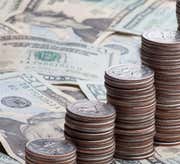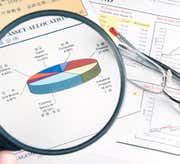The price-to-book value ratio is also helpful to investors valuating a company. It compares a stock's per-share price (market value) to its book value (shareholders' equity). The price-to-book value ratio, expressed as a multiple (i.e. how many times a company's stock is trading per share compared to the company's book value per share), is an indication of how much shareholders are paying for the net assets of a company.
The book value of a company is the value of a company's assets expressed on the balance sheet. It is the difference between the balance sheet assets and balance sheet liabilities and is an estimation of the value if it were to be liquidated.
The price/book value ratio, often expressed simply as "price-to-book", provides investors a way to compare the market value, or what they are paying for each share, to a conservative measure of the value of the firm.
Formula:
Components
The dollar amount in the numerator, $67.44, is the closing stock price for the fictitious Zinzibar Holdings as of December 30, 2017, as reported in the financial press or over the Internet in online quotes. In the denominator, the book value per share is calculated by dividing the reported shareholders' equity (balance sheet) by the number of common shares outstanding (balance sheet) to obtain the $18.90 book value per-share figure. By simply dividing, the equation gives us the price/book value ratio indicating that, as of Zinzibar Holdings' 2017 fiscal yearend, its stock was trading at 3.6-times the company's book value of $18.90 per share.
Variations:
A conservative alternative to using a company's reported shareholders' equity (book value) figure would be to deduct a company's intangible assets from its reported shareholders' equity to arrive at a tangible shareholders' equity (tangible book value) amount. For example, Zinzibar Holdings' FY 2017 balance sheet reports goodwill (in millions $) of $2,428.8 and net intangible assets of $756.6, which total $3,185.4. If we deduct these intangible assets from its shareholders' equity of $4,682.8 of the same date, Zinzibar Holdings is left with a significantly reduced tangible shareholders' equity of $1,497.4. Factoring this amount into our equation, the company has a book value per share of only $6.04, and the price/book value ratio then skyrockets to 11.2 times.
Commentary:
If a company's stock price (market value) is lower than its book value, it can indicate one of two possibilities. The first scenario is that the stock is being unfairly or incorrectly undervalued by investors because of some transitory circumstance and represents an attractive buying opportunity at a bargain price. That's the way value investors think. It is assumed that the company's positive fundamentals are still in place and will eventually lift it to a much higher price level.
On the other hand, if the market's low opinion and valuation of the company are correct (the way growth investors think), at least over the foreseeable future, as a stock investment, it will be perceived at its worst as a losing proposition and at its best as being a stagnant investment.
Some analysts feel that because a company's assets are recorded at historical cost that its book value is of limited use. Outside the United States, some countries' accounting standards allow for the revaluation of the property, plant and equipment components of fixed assets in accordance with prescribed adjustments for inflation. Depending on the age of these assets and their physical location, the difference between current market value and book value can be substantial, and most likely favor the former with a much higher value than the latter.
Also, intellectual property, particularly as we progress at a fast pace into the so-called "information age", is difficult to assess in terms of value. Book value may well grossly undervalue these kinds of assets, both tangible and intangible.
The P/B ratio therefore has its shortcomings but is still widely used as a valuation metric. It is probably more relevant for use by investors looking at capital-intensive or finance-related businesses, such as banks.
In terms of general usage, it appears that the price-to-earnings (P/E) ratio is firmly entrenched as the valuation of choice by the investment community. (Skip ahead to the P/E chapter here.)
Investment Valuation Ratios: Price/Cash Flow Ratio
-
 Investing
InvestingMarket value versus book value
Understanding book value and market value is helpful in determining a stock's valuation and how the market views a company's growth prospects. -
 Investing
InvestingBook Value: How Reliable Is It For Investors?
In theory, a low P/B ratio means you have a cushion against poor performance. In practice, it is much less certain. -
 Investing
Investing5 must-have metrics for value investors
In this article, we outline the five ratios that can help value investors find the most undervalued stocks in the market. -
 Investing
InvestingDigging Into Book Value
This calculation will serve up your portion of the shareholder pie. -
 Investing
InvestingBook Value Per Share for Banks: Is It a Good Measure? (WFC, BAC)
Find out why bank stocks usually trade below book value and understand how trading activities increase banks' risk exposures and affect valuation. -
 Investing
InvestingSXC Health Solutions Corp. (USA) Among the Nasdaq's Biggest Movers
The market is having a bad day so far: the Nasdaq is trading down 0.3%; the S&P 500 has declined 0.4%; and the Dow has slipped 0.5%. The Nasdaq Composite Index is a capitalization-weighted index, ... -
 Investing
InvestingDeep Discount-To-Book Value Stocks
With the right company, buying at a discount-to-book value could prove fruitful. -
 Investing
InvestingHow to Invest Your Excess Cash in Undervalued Securities
Learn how even small investors can shoot for substantial capital gains by starting to invest their excess cash in undervalued securities. -
 Investing
InvestingHow Buybacks Warp The Price-To-Book Ratio
Relying on price-to-book can get ugly if a company has repurchased stock. Learn why.



